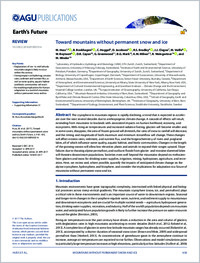Toward mountains without permanent snow and ice
- Huss, Matthias Laboratory of Hydraulics, Hydrology and Glaciology (VAW), ETH Zurich, Switzerland - Department of Geosciences, University of Fribourg, Fribourg, Switzerland
- Bookhagen, B. Institute of Earth and Environmental Science, University of Potsdam, Germany
- Huggel, Christian Department of Geography, University of Zurich, Switzerland
- Jacobsen, D. Department of Biology, University of Copenhagen, Denmark
- Bradley, R.S. Department of Geosciences, University of Massachusetts, Amherst Mas., USA
- Clague, J.J. Department of Earth Sciences, Simon Fraser University, Burnaby, Canada
- Vuille, M. Department of Atmospheric and Environmental Sciences, University at Albany, New York, USA
- Buytaert, W. Department of Civil and Environmental Engineering, and Grantham Institute, Imperial College London, UK
- Cayan, D. R. Scripps Institution of Oceanography, University of California, San Diego Cal., USA
- Greenwood, G. Mountain Research Initiative, University of Bern, Switzerland
- Mark, B. G. Department of Geography and Byrd Polar and Climate Research Center, Ohio State University, Columbus, USA
- Milner, A.M. School of Geography, Earth and Environmental Sciences, University of Birmingham, UK
- Weingartner, R. Institute of Geography, University of Bern, Switzerland
- Winder, M. Department of Ecology, Environment, and Plant Sciences, Stockholm University, Sweden
-
01.05.2017
Published in:
- Earth’s Future. - 2017, vol. 5, no. 5, p. 2016EF000514
English
The cryosphere in mountain regions is rapidly declining, a trend that is expected to accelerate over the next several decades due to anthropogenic climate change. A cascade of effects will result, extending from mountains to lowlands with associated impacts on human livelihood, economy, and ecosystems. With rising air temperatures and increased radiative forcing, glaciers will become smaller and, in some cases, disappear, the area of frozen ground will diminish, the ratio of snow to rainfall will decrease, and the timing and magnitude of both maximum and minimum streamflow will change. These changes will affect erosion rates, sediment, and nutrient flux, and the biogeochemistry of rivers and proglacial lakes, all of which influence water quality, aquatic habitat, and biotic communities. Changes in the length of the growing season will allow low-elevation plants and animals to expand their ranges upward. Slope failures due to thawing alpine permafrost, and outburst floods from glacier- and moraine-dammed lakes will threaten downstream populations. Societies even well beyond the mountains depend on meltwater from glaciers and snow for drinking water supplies, irrigation, mining, hydropower, agriculture, and recreation. Here, we review and, where possible, quantify the impacts of anticipated climate change on the alpine cryosphere, hydrosphere, and biosphere, and consider the implications for adaptation to a future of mountains without permanent snow and ice.
- Faculty
- Faculté des sciences et de médecine
- Department
- Département de Géosciences
- Language
-
- English
- Classification
- Hydrology
- License
-
License undefined
- Identifiers
-
- RERO DOC 306741
- DOI 10.1002/2016EF000514
- Persistent URL
- https://folia.unifr.ch/unifr/documents/306503
Statistics
Document views: 167
File downloads:
- pdf: 308
